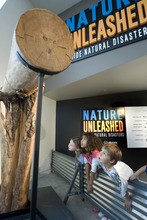This is an archived article that was published on sltrib.com in 2013, and information in the article may be outdated. It is provided only for personal research purposes and may not be reprinted.
Ten-year-old Brennan Phifer switched a couple levers and pressed a button. Suddenly, an enormous gray cloud exploded on the screen in front of him in a virtual volcanic eruption.
"It's spraying some magma out of the earth," he said about the virtual disaster. "This is so awesome."
The station at the Natural History Museum of Utah allowed him to control the amount of gas and silica brewing in the volcano, showing him how each material affected the eruption.
It's part of the newly built museum's first traveling exhibit, titled Nature Unleashed. Created at The Field Museum in Chicago and including natural disasters of nearly every type, the exhibit's subject has a tragic resonance with the huge tornado that ripped through Oklahoma this week, killing 24 people. The museum will donate 25 percent of its ticket sales for opening weekend to the American Red Cross.
"Our hearts go out to the families," said Salt Lake City Fire Chief Kurt Cook, who responded to a tornado in Utah's capital city in 1999 that killed one person.
"As I walk through here … every display has similarities," he said. "It opens your eyes to the power of nature and how destructive and terrible it can be."
One of the displays provides people a view inside a tornado through footage shot inside a specially reinforced housing in Iowa in 2004 and shown on giant screens surrounding the viewer.
"I just thought it would be wind and everything," said Sophia Kuder, 9, her brown eyes widening. "I didn't know there would be all the debris."
Other natural disasters also hit close to home. Salt Lake City is located along the Wasatch fault, an earthquake fault that runs through most of the populated areas of northern Utah.
"We could have a large earthquake anytime, a 7 or a 7.5," said seismologist Katherine Whidden.
The fault has a reoccurrence rate of 1,200 years — and the last quake here was 1,400 years ago, she said.
A display added locally to the exhibit illustrates why the Salt Lake area is particularly vulnerable: the soil is susceptible to liquefaction that can create more damage than the quake itself.
It showed a miniature house, car and person in tub filled with wet, sandy soil. Under the eye of museum public program manager Lisa Thompson, children simulated an earthquake with rubber mallets and watched the little scene sink.
"Is there anything we can do to make the house stand up better?" said Thompson.
"Put clay in the soil!" said Madison Jones, one of 30 fourth-graders from Rose Creek Elementary in Riverton who came to a preview of the exhibit Thursday. They read the stories of Hurricane Katrina survivors, jumped to test out a seismograph display and saw a stop sign crushed by a tornado.
Sarah George, the museum's executive director, said Nature Unleashed shows "the natural and often fierce forces that shape our planet."
Twitter: @lwhitehurst —
If you go
I Nature Unleashed opens Saturday at the Natural History Museum of Utah, 301 Wakara Way. Tickets are $11 for adults, $9 for seniors or juniors ages 13 to 24, $8 for kids ages 3-12 and free for kids under 3. They also include entrance to the rest of the museum. The exhibit runs through Dec. 8.







